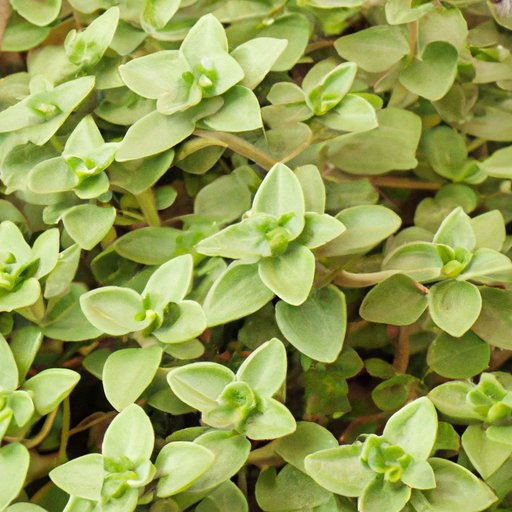Introduction
If you are a fan of adding herbs to your cooking, you’ve likely heard of Marjoram. This flavorful herb has a long history of culinary uses and medical benefits, making it a pantry staple in many households. In this article, we will explore the history of Marjoram, health benefits, cooking tips, and growing it in your own garden. By the end of this piece, you will have a comprehensive guide to everything you need to know about Marjoram.
Discovering the History & Culinary Uses of Marjoram: A Comprehensive Guide
Marjoram originates from the Mediterranean area, and ancient Egyptians, Greeks, and Romans used it both for medicinal purposes and cooking. Its flavor profile can be described as a combination of sweet, savory, and slightly bitter, making it incredibly versatile for culinary purposes.
Marjoram is mainly used to flavor poultry, fish, vegetables, and soups. It is often used in Italian and Greek cuisines and pairs well with basil, parsley, rosemary, and thyme. It is also a key ingredient in the popular Italian seasoning blend.
There are different types of Marjoram available, including Sweet Marjoram and Wild Marjoram. Sweet Marjoram is the most commonly used and has a mild and delicate flavor with a gentle sweetness. Wild Marjoram, also called Oregano, is known for its strong and robust flavor profile. It is often used in Greek and Mexican cuisines.
5 Health Benefits of Using Marjoram in Your Cooking
Marjoram contains a variety of essential vitamins and minerals that can benefit your health. Here is a list of some of the health benefits that come with using Marjoram in your cooking:
1. Aids digestion: Marjoram has anti-inflammatory properties that help soothe and heal your digestive system. It can also help relieve stomach discomforts such as bloating, gas, and constipation.
2. Improves mental health: Marjoram has calming properties that can help relieve stress, anxiety, and insomnia. It can also improve your mood and promote relaxation.
3. Prevents certain diseases: Marjoram has antioxidant properties that help prevent cell damage, reducing the risk of chronic diseases. It also has antibacterial properties that can fight off harmful bacteria in your body.
4. Regulates blood sugar: Marjoram has compounds that can aid in regulating blood sugar levels, making it beneficial for people with type 2 diabetes.
5. Reduces inflammation: Marjoram contains compounds that can help reduce inflammation in your body, reducing the risk of chronic diseases such as heart disease and cancer.
Cooking with Marjoram: Tips, Tricks, and Delicious Recipes
Marjoram is a versatile herb that can be used in a variety of dishes. Here are some tips and tricks to help you use it in your cooking:
1. Use it to season poultry: Marjoram pairs well with chicken, turkey, and duck. Rub Marjoram onto the meat before roasting or add to the marinade for an extra pop of flavor.
2. Add it to soups and stews: Marjoram is a great herb to add to soups and stews, especially vegetable ones. Add it towards the end of cooking for optimal flavor.
3. Use it in marinades: Marjoram adds depth of flavor to marinades for meat and vegetables. Mix it with olive oil, vinegar, and your favorite spices for a tasty marinade.
Here are some popular and delicious recipes using Marjoram:
1. Marjoram-Roasted Chicken: Combine Marjoram with garlic, olive oil, lemon juice, salt, and pepper. Rub over chicken and roast in the oven for a delicious and flavorful meal.
2. Tomato Marjoram Soup: Cook onions and garlic in olive oil, add canned tomatoes, chicken broth, and Marjoram. Simmer until the flavors develop, then blend until smooth for a comforting soup.
Understanding the Difference Between Marjoram vs. Oregano
It’s easy to confuse Marjoram with Oregano, as they look similar and are often used in the same cuisines. Here is a comparison of the two herbs:
Difference between Marjoram and Oregano: Although they are both part of the mint family, Marjoram has a milder flavor profile, while Oregano has a stronger and more robust taste. Oregano is often used in Mexican, Italian, and Greek cuisines, while Marjoram is used mainly in Italian and Greek cuisines.
Common uses of Oregano in cooking: Oregano is used mainly in pizza and pasta sauces, marinades, and dressings. It is also often used on top of roasted vegetables, meat, and fish.
When to use Marjoram instead: Marjoram is a great substitute for Oregano in any recipe that requires a milder herb. It is a great addition to salad dressings, soups, and vegetable dishes.
A Beginner’s Guide to Growing and Harvesting Your Own Marjoram
If you love Marjoram and want to try growing it in your own garden, here is a beginner’s guide:
How to grow Marjoram from seed and in a garden: Marjoram is easy to grow from seed and can grow in containers or in a garden. It prefers well-drained soil and full sun. Sow the seeds in the early spring, and they will germinate in 7-14 days.
How to care for Marjoram plants and how to harvest them: Water the plants regularly and keep the soil moist but not waterlogged. Pinch off the leaves regularly to encourage bushy growth, and harvest the leaves as needed by cutting them off the plant and leaving a few inches of stem.
Popular ways to use freshly grown Marjoram in your cooking: Use freshly grown Marjoram in marinades, dressings, and sauces. It pairs well with other herbs like basil, thyme, and parsley.
Conclusion
Marjoram is a versatile herb with a long history of culinary and medicinal uses. It has numerous health benefits, making it a great addition to any dish. Whether you are using it to flavor poultry, soups, or marinades or growing it in your own garden, Marjoram is a must-have herb in the kitchen.
If you’re interested in exploring Marjoram further, I encourage you to try it out in a recipe or grow it in your own garden.
